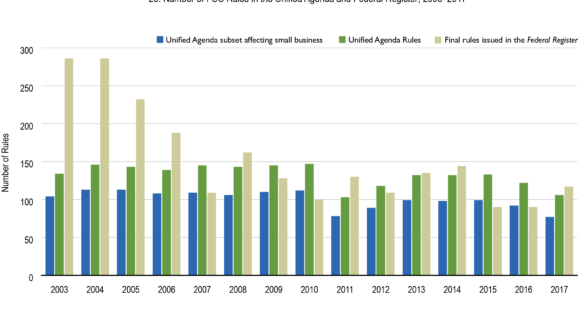Regulation and the FCC
Ten Thousand Commandments 2018 - Chapter 9

The Federal Communications Commission is by no means the heavyweight among regulators as gauged by the number of rules issued.
Yet the FCC merits highlighting given its great influence over a major economic sector regarded as a growth engine in today’s economy: telecommunications, the Internet, and the information economy generally. An agency’s rule count is not all that matters because a handful of rules can have an outsized impact.

The FCC is an expensive agency. It spent $459 million on regulatory development and enforcement during FY 2016175 and likely accounts for more than $100 billion in annual regulatory and economic impact. Figure 23 shows the FCC’s final rules in the Federal Register during the past decade, its overall number of rules in the fall Agenda, and its Agenda rules affecting small business.
Its 106 rules in 2017 in the Agenda pipeline are surpassed by nine other departments or agencies (see Table 5) and its count of five economically significant rules is also exceeded or equaled by that of nine other agencies (see Table 7). Of the 3,208 total rules in the fall 2017 Agenda pipeline, 106, or 3 percent, were in the works at the FCC (Figure 23). Seventy-seven of the FCC’s rules in the fall 2017 pipeline, or 73 percent of its total, affect small business, as Figure 23 and Table 8 show.
The FCC finalized 117 rules in the Federal Register in 2017, up from 90 in 2016. FCC final rules in the Federal Register numbered as high as 313 back in 2002, then declined steadily during the decade to lows of 109 in 2012, and then to 90 in both 2015 and 2016 (see far-right bars in Figure 23). As of February 21, 2018, the FCC had finalized 19 rules in the Federal Register.
A pro-regulatory mindset dominated the commission during the Obama administration, most notably in the push to apply utility regulation to broadband in pursuit of so-called net neutrality rules. Those rules are now subject to a new rulemaking to overturn spearheaded by new FCC Chairman Ajit Pai. This again illustrates the importance of distinguishing regulatory rules from deregulatory ones.
Of the 140 economically significant rules in the works across the entire federal government, five belong to the FCC (see Table 7 and Box 4). Such rulemakings—along with other FCC rules in the Agenda pipeline and the dozens made final each year—present opportunities for either liberalization of telecommunications or avenues for new central regulatory oversight and protracted legal battles. The commission had chosen the latter in recent years, but has changed under Chairman Pai.
Read Chapter 10 – Liberate to Stimulate
Read Chapter 8 – Government Accountability Office Database on Regulations